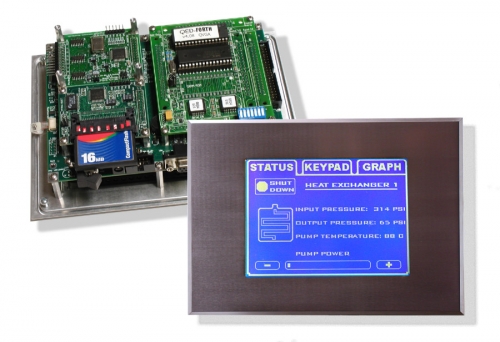QVGA Controller Users Guide
Embedded Computer and Advanced Operator Interface
Welcome, and thanks for purchasing the QVGA Controller™. This manual provides instructions for using your new embedded computer. The QVGA Controller is a state-of-the-art embedded microcontroller with an advanced operator interface. It’s an ideal brain for instruments that need a highly visible graphical user interface (GUI), touchscreen control, computational power, I/O, and serial communications – all in one compact package.
Commanded remotely from a PC, or used stand-alone, it provides real-time control of dozens of analog and digital I/O lines. Use it for scientific instruments, machine or process control, or as an advanced operator interface for existing products. Its real-time multitasking operating system facilitates concurrent functioning of its user interface, I/O, and application software. You may use this compact, integrated device as the core hardware, software and user interface for your new products – wherever you need an I/O-rich computer and an advanced user interface.
The QVGA Starter Kit includes everything you need to develop a prototype instrument with an advanced GUI: the QVGA Controller with a monochrome display, battery back-up for 128K RAM memory, a full documentation package, power supply and all cables. For a sleek look you can add a black anodized aluminum bezel. The QVGA Controller can be either flush mounted using the bezel or directly mounted to a panel with a cutout.
Prerequisite Knowledge
The QVGA Controller is intended for use by experienced programmers or any technically minded person up to the challenge of real-time programming. We assume that if you’re designing a product requiring an embedded computer, you have experience in the design of the hardware and software needed to customize the QVGA Controller to your product, and an understanding of the basics of writing, compiling and debugging software programs. You should be comfortable programming in either the C or Forth programming languages; you can program the QVGA Controller in either. This manual is geared to the C programmer. If your would rather program in Forth, give us a call and we’ll send you the Forth programmers manual. We recommend the following references for novice programmers:
- The C Programming Language, by Kernighan and Ritchie
- C: A Reference Manual, by Harbison and Steel
Motorola’s M68HC11 Reference Manual and MC68HC11F1 Technical Data Manual are included with this documentation package as Adobe Acrobat Portable Document Format (.pdf) files.
How to Use this Documentation
This manual is laid out in several parts, in an order we hope you find most useful. We have invested a lot of effort to make this documentation instructive and helpful. The available software and hard-ware functions are all described in detail, and many coded examples are presented. For those who are designing turnkeyed instruments, we have included a complete turnkeyed application program. This well documented program illustrates how to use dozens of features, including the graphical user interface, interrupts, floating point math, formatted display of calculated results, multitasking, and automatic program startup. The source code is included on your CD-ROM. This sample pro-gram can serve as a useful template for a wide variety of applications. This manual contains the following parts:
Part 1, Getting Started: A Quick Tour of the QVGA Controller, will familiarize you with the QVGA Controller (Chapter 1) and its programming environment, and get you writing your first program (Chapter 2). These first two chapters guide you through the QVGA Controller’s hardware, explain how to establish communications with it, tell you how to install your compiler, and show you how to compile and run your first program.
After working through the examples of Chapter 2 you will have exercised some of the key hardware and software features of your controller. You might then leaf through the categorized list at the beginning of the C Function Glossary in an Appendix to get a feel for the wealth of precoded library functions available for you to use.
Part 2, Programming the QVGA Controller, provides everything you need to know to master real-time programming on the QVGA Controller.
Part 3, Communications, Measurement and Control, focuses on the QVGA’s hardware resources – A/D, D/A, serial communications, timer-controlled I/O, real-time clock and others – and provides examples for using each. Part 4, Putting It All Together, introduces a real-time interactive application, and provides code you can use as a template for your application. It also discusses the nuts and bolts of product inte-gration, mounting, noise considerations and power requirements.
Part 5, Reference Data, contains detailed specifications, schematics, dimensions, data sheets and glossaries of C functions available for your use.
Obtaining Code Examples and Example Applications
Please check our website periodically at www.mosaic-industries.com, where we’ll be posting code examples and example applications, and providing software updates and enhancements.
For Technical Help (or just to chat) Contact Us
We have tested and verified the sample code in this user’s guide to the best of our ability, but you may find that some features have changed, or even that we have made a mistake or two. If you find an error, please call us and we’ll fix it pronto.
If you are facing a challenging software hurdle, or a hardware problem in interfacing to our products, please don’t hesitate to Contact Us. We can often help you over the hurdle and save you a lot of time. We provide free technical help to all registered, licensed users.
Many of the designations used by manufacturers and sellers to distinguish their products are claimed as trade-marks. Where those designations appear in this document, and Mosaic Industries, Inc. was aware of a trade-mark claim, the designations have been printed in caps or initial caps. For example, Microsoft, Microsoft Windows, and Visual Basic are registered trademarks of Microsoft Corporation.
While every precaution has been taken in the preparation of this manual, Mosaic assumes no responsibility for errors or omissions, or for damages resulting from the use of the information contained herein.
|
Published by: |
Mosaic Industries, Inc. |
Copyright © 2005-2011 Mosaic Industries, Inc. All rights reserved.

